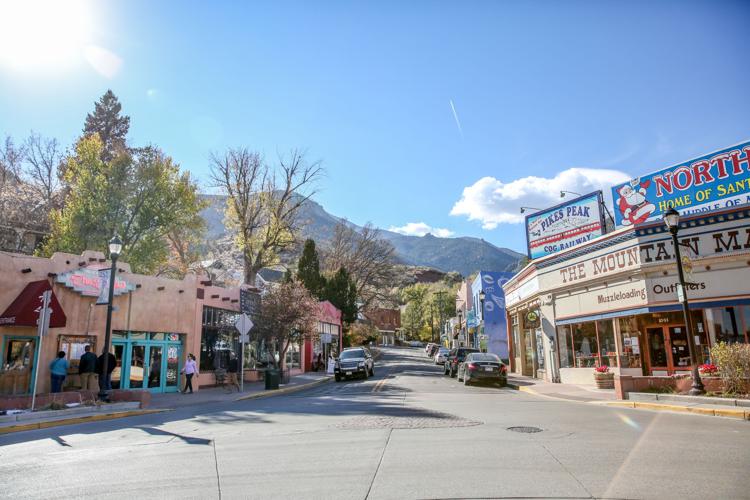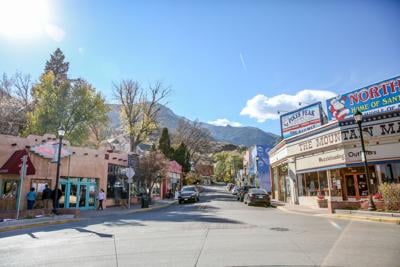If you’re familiar with the tiny town of Manitou Springs located outside of Colorado Springs, you’ve probably seen a few of the unique drinking fountains spread throughout town. And if you’ve been bold enough to try one, you’ve definitely picked up on the unique flavor and carbonated mouthfeel of the water. Don’t worry, there’s nothing wrong with the local plumbing. The water from each spout is safe to drink and comes out of the earth this way naturally, each filled with a unique mixture of minerals.
NEARBY: Colorado’s Stairway to Heaven!
Over the course of many years, an enormous amount of rainwater and snowmelt from around the Pikes Peak region has soaked into underground rock fractures. As the water heats and mineralizes, it flows upwards into limestone caverns where it becomes carbonated and eventually returns to the surface, filtered and free of contamination.

Downtown Manitou Springs.
Currently, eight of these mineral springs are open for the public to sample. We’ve put together a breakdown of what to expect from each one, and here’s a link to a walking map for an easy tour.
1. Iron Spring Geyser
This fin-shaped fountain is named for its high iron content, a mineral that can be beneficial in cellular level movement of oxygen. This spring is also very high in fluoride, calcium, and silica.
NEARBY: This Railroad Peaks at 14,000 Feet!
2. Twin Spring
Originally two springs now merged into one, Twin Spring is high in magnesium. It might be more notable, however, for its specific blend of potassium and calcium that give it a uniquely sweet taste.
3. Wheeler Spring
Wheeler Spring has the highest content of copper out of the bunch. Many believe that copper supplements are able to help with wound healing, osteoarthritis, and brittle bones.
NEARBY: The Haunted Tunnels of Gold Camp Road!
4. Stratton Spring
Many people find the taste of Stratton Spring to be enjoyable and comparable to soda water, making it one of Manitou’s most popular. It’s not particularly high in any specific mineral, making it one of the more neutral flavor blends on this list.
5. Shoshone Spring

Shoshone Spring, Manitou Springs.
With the highest alkalinity of the eight open springs, Shoshone Spring is also the most jam packed with minerals. Compared to the rest, it comes out on top in seven different categories, including chloride, calcium, and zinc. It’s also the warmest—the water pumps out at around 70 degrees Fahrenheit.
6. 7-Minute Spring
Though not known for being especially high in any specific mineral, 7 Minute Spring has a very diverse makeup, filled with minerals like potassium, sodium, and zinc. Fun fact: the spring got it’s name because built up carbonation used to lead to a water release every 7 minutes.
7. Navajo Spring
The Navajo Spring blend is one of the more commercialized springs and has actually been bottled before and sold around the nation as a popular soda water. Similar to the Stratton Spring, it’s not especially high in any specific mineral, giving it a pleasant and more neutral taste.
8. Cheyenne Spring

OutThere Colorado’s Social Media Coordinator, Spencer McKee, tastes Manitou’s Cheyenne Spring.
Though high in magnesium and high in potassium, Cheyenne Spring is another pleasantly flavored spring that has remained popular among visitors throughout the years. It’s believed that it pumps up to Manitou from roughly one mile underground.

Manitou Springs is the perfect small town to spend an afternoon exploring.
Now that you know a little more about the namesake behind Manitou Springs, you should totally stop by for a free sampling of the goods. Walking tours are totally doable and a map can be found at the Manitou Springs Visitor Center, located at 354 Manitou Avenue. Just make sure to bring some cups so you don’t get soaked!













(0) comments
Welcome to the discussion.
Log In
Keep it Clean. Please avoid obscene, vulgar, lewd, racist or sexually-oriented language.
PLEASE TURN OFF YOUR CAPS LOCK.
Don't Threaten. Threats of harming another person will not be tolerated.
Be Truthful. Don't knowingly lie about anyone or anything.
Be Nice. No racism, sexism or any sort of -ism that is degrading to another person.
Be Proactive. Use the 'Report' link on each comment to let us know of abusive posts.
Share with Us. We'd love to hear eyewitness accounts, the history behind an article.